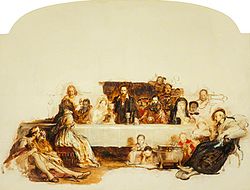John Knox
John Knox (c. 1510 – 24 November 1572) brought the Protestant Reformation to Scotland and was one of the founders of the Presbyterian Church. Knox joined the movement to change the Roman Catholic Church in Scotland. He married twice and had five children. Knox preached until he died.
John Knox | |
|---|---|
 19th-century engraving of Knox | |
| Born | c. 1514[1] Giffordgate, Haddington, Scotland |
| Died | 24 November 1572 (aged 58 or 59) Edinburgh, Scotland |
| Alma mater | University of St. Andrews |
| Occupation | Pastor, author, reformer |
| Theological work | |
A fight between Catholic France and Protestant England for Scotland began again because of the Reformation. Sometimes, France had more power. Other times, England had it. Knox spent many months as a galley slave. He also spent time in exile because of his Protestant beliefs. During a trip to Scotland, Knox's preaching helped the Protestant movement. Several Protestant noblemen came together and made a group called the Lords of the Congregation. When the group had more power, they invited Knox back to Scotland to stay.
In 1500 and 1561, the Scottish Parliament accepted the Reformed confession of faith made by Knox and other people.
Knox often debated with Mary, Queen of Scots. In his book History of the Reformation in Scotland, he writes about his five "conversations" with the Roman Catholic queen. In one of those conversations, Mary asked Knox what right he had to rebuke the queen so directly and openly. Knox replied, "I am a worm of this earth, and yet a subject...but I am a watchman, both over the realm (land) and the Kirk [Church] of God...For that reason I am bound in conscience (it is my duty) to blow the trumpet publicly (openly)".
Mary's violent life finally made even many of her Catholic supporters abandon her. She gave up the throne, which allowed Knox to pass the Reformation in Scotland and form the Presbyterian Church.
John Knox Media
Wishart preaching against Mariolatry, with Knox at his back (far right)
Portrait of Knox from Theodore Beza's Icones
Statue of John Knox at the Reformation Wall monument in Geneva
The Auditoire de Calvin where Knox preached while in Geneva, 1556–1558
The Preaching of John Knox Before the Lords of the Congregation (in the Parish Church of St. Andrew's, 10 June 1559) by David Wilkie
Perth's St John's Kirk in modern times
Study for John Knox Dispensing the Sacrament at Calder House by David Wilkie. The work was intended as a companion to Wilkie's Preaching of Knox before the Lords of the Congregation above.
References
- ↑ MacGregor 1957, pp. 229–231; Ridley 1968, pp. 531–534. Until David Hay Fleming published new research in 1904, John Knox was thought to have been born in 1505. Hay Fleming's conclusion was that Knox was born between 1513 and 1515. Sources using this date include MacGregor 1957, p. 13 and Reid 1974, p. 15. Ridley notes additional research supports the later date which is now generally accepted by historians. However, some recent books on more general topics still give the earlier date for his birth or a wide range of possibility; for example: Arthur. F. Kinney and David. W. Swain (eds.)(2000), Tudor England: an Encyclopedia, p. 412 (between 1505 and 1515); M. E. Wiesner-Hanks (2006), Early Modern Europe, 1450–1789, Cambridge University Press, p. 170 (1505?); and Michael. A. Mullet (1989), Calvin, Routledge, p. 64 (1505).








